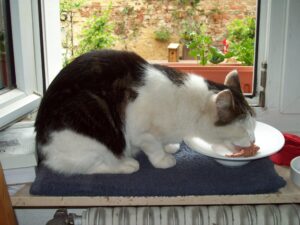Key Takeaways
Consult your vet to ensure your cat is fit for air travel and up-to-date with vaccinations.
Select a carrier that meets airline requirements and is comfortable for your cat.
Gradually acclimate your cat to the carrier to reduce stress during travel.
Prepare a checklist of necessary items to bring on the day of travel.
Understand your cat’s behavior and stress signals to provide comfort during the flight.
Ensuring Your Cat’s Comfort and Safety in the Skies
My cat would rather I never travel let alone her. Even a trip to the other side of town for a nail clip or vet check-up is asking way too much of her royal highness. However, there are times when some of us need or want to take our little one with us – and that could mean boarding a plane.
The key is to be prepared.
Even for us humans the skies can be an unfamiliar and daunting place. As for your cat our job is to keep her/him as comfortable and unruffled as possible. And with the right approach, you can ensure a smooth and stress-free journey. Let’s dive into how you can achieve this, step by step.
Pre-flight Health Check
Before even considering booking a flight, it’s crucial to discuss your travel plans with your vet. (I almost said cat!) They, the vet that is, will assess whether your cat is suitable for air travel based on age, health, and temperament. Remember, some cats, like young kittens, seniors, or those with underlying health issues, may find flying particularly challenging. Not all cats can tolerate a joy ride and are better left in the hands of a caring provider if that’s the case. If it’s out of necessity, or the vet gives the green light, then there are ways to make it happen and keep your feline fritter purring.
During the vet visit, make sure your cat’s vaccinations are current and obtain any necessary health certificates required by the airline or your destination. This is also the time to discuss any concerns you might have, such as how to handle your cat’s anxiety or dietary needs during the trip.
Selecting an Airline-Approved Carrier
Choosing the right carrier is not just about comfort—it’s also about compliance. Airlines have specific regulations for carriers in the cabin and cargo hold. Here’s what you need to consider:
Size: The carrier should be large enough for your cat to stand, turn around, and lie down comfortably.
Material: Durable materials like hard plastic can provide better protection, while soft carriers may be allowed in the cabin.
Ventilation: Adequate airflow is essential, so look for a carrier with multiple mesh panels.
Security: Secure zippers and latches are a must to prevent any Houdini-like escapes.
Check the airline’s pet-friendly travel guide or call their customer service for the most up-to-date carrier requirements. This will save you from any last-minute surprises at the airport.
Understanding Behavior and Stress Signals
Cats communicate their discomfort in various ways. Be aware that some of these behaviors may display themselves after you land at your destination. Recognizing these signs can help you provide the necessary comfort during travel. Watch for signs of stress and learn how to respond by reading about traveling with your cat.
Hiding or attempting to escape
Excessive meowing or growling
Panting or open-mouth breathing
Lack of appetite or refusal to drink
Knowing these signals can help you act quickly to soothe your cat, whether it’s through a gentle voice, a favorite toy, or a calming pheromone spray.
Now, let’s prepare your cat for the upcoming adventure in the skies.
Getting Your Cat Ready for Takeoff
Carrier Acclimatization
It’s essential to get your cat used to their carrier well before the day of travel. This can greatly reduce their stress levels and make the journey more comfortable for both of you. Start by placing the carrier in a common area of your home, with the door open, so your cat can explore it at their own pace.
Gradual Familiarization Exercises
Put the carrier in a familiar place where your cat can get used to its presence and leave the door open or the top off. Encourage your cat to spend time in the carrier by placing treats, catnip toys, or their favorite blanket inside. Gradually increase the time they spend in the carrier each day. You can also feed them inside it to create a positive association.
Creating a Cozy and Familiar Space
Make the carrier inviting by lining it with a soft bed or a piece of clothing with your scent. This familiarity can be a great comfort to your cat during the unsettling experience of flying.
Mock Travel Sessions
Practice Runs
Once your cat is comfortable being in the carrier, start doing practice runs. This can be as simple as carrying them around the house or taking short drives. The goal is to acclimate them to the sensation of movement while secured in their carrier. Make it fun and reward them with a little treat when you end your practice.
Desensitization to Travel Noises
Exposure to the sounds of travel can also help desensitize your cat to the noisy environment of an airport. This might sound unusual, but play recordings of airport sounds at a low volume and gradually increase it over time. This will help them become less reactive to the real thing. You can find these sounds on Google.
Travel Day: A Smooth Journey from A to B
Checklist for Departure Day
As travel day approaches, prepare a checklist to ensure nothing is forgotten. This should include your cat’s health documentation, a familiar blanket or toy, and any travel accessories needed for the journey.
Documentation and ID Tags
Ensure your cat has a sturdy collar with an ID tag that includes your contact information. Carry a copy of your cat’s vaccination records and any required health certificates. Some destinations may have specific entry requirements, so do your homework well in advance.
Necessary Supplies for the Carry-on
In your carry-on, pack the essentials for your cat’s comfort and well-being:
A collapsible water bowl and a small bottle of water
A few portions of their regular food
A favorite toy or two to provide comfort and distraction
Any medications your cat may need
Navigating Airport Security with Your Cat
Going through airport security can be one of the most stressful parts of traveling with a cat. Know ahead of time that you’ll likely need to take your cat out of their carrier so it can be x-rayed. Hold your cat securely or ask for a private screening room if they’re prone to escape attempts. Keep your stress levels under check as we know how sensitive our feline friends are to our personal energy. Soothing sounds and a firm, methodical unwavering approach is best suited for this kind of situation. Don’t be hesitant when it comes to what has to be done. Just do it and get on with things.
Carrier Handling Procedures
When placing the carrier on the security belt, do so gently to avoid startling your cat. Keep a calm demeanor, as mentioned earlier cats can pick up on your stress, which can, in turn, increase their own anxiety. For more information on traveling with your pet, check out our guide on pet-friendly travel.
Keeping Your Cat Calm Amidst the Hustle
Throughout the airport experience, maintain a soothing presence for your cat. Speak to them in a calm voice and offer reassurance through the carrier door. If possible, drape a light blanket over the carrier to create a more secluded environment and reduce visual stressors.
Keeping Kitty Calm at Altitude
In-Flight Essentials
Once you’re in the air, the environment will change again. The cabin pressure and hum of the aircraft are new sensations for your cat. During the flight, it’s important to:
Monitor your cat for signs of distress or discomfort
Ensure they have access to water to stay hydrated
Check that the carrier is secure and not in a position where it could be jostled or tipped over
Example: On a recent flight, I saw a fellow passenger who frequently checked on their cat, offering soothing words and placing their hand against the carrier for comfort. It was clear that these small gestures provided reassurance to the cat during the flight.
Hydration and Comfort Checks
Dehydration can be a risk during flights due to the dry cabin air. Offer your cat water periodically, but be mindful of turbulence when opening the carrier. It’s unlikely your kitty will drink much, if at all, but it’s important to always have water available. Also, check that they are not too hot or too cold, adjusting their covering as needed.
Signs of Stress and How to Mitigate Them
Keep an eye out for the stress signals mentioned earlier. If you notice any, respond calmly and promptly. You might not be able to eliminate all stress for your cat, but you can certainly minimize it with your actions and preparedness.
Remember, every cat is different, and what works for one may not work for another. Patience and attentiveness will go a long way in ensuring a peaceful journey for your beloved pet.
Setting Up a Safe Space on Arrival
After landing, your priority is to help your cat transition to their new environment as smoothly as possible. The first step is to establish a safe, quiet space where they can rest and feel secure. Avoid places where there is a lot of activity and noise when letting you cat out of the carrier after a flight.
Adjusting to New Surroundings
Once at your destination, set up a familiar area with items from home like their bed, toys, and litter box. Keep routines as consistent as possible to help your cat feel at ease. Allow them to explore at their own pace, and be there to offer comfort and affection as they adjust.
Post-travel Cat Health Monitoring
Keep a close eye on your cat for any signs of illness or distress in the days following travel. Changes in behavior, appetite, or bathroom habits can indicate stress or a health issue, so if you notice anything concerning, don’t hesitate to contact a vet.
Frequently Asked Questions
Traveling with cats can raise a lot of questions. Here are some common concerns cat owners have when flying with their pets.
Can I give sedatives to my cat before flying?
Consult with your vet before administering any sedatives. While they can help some cats relax, sedatives can also pose risks, especially at high altitudes. There are alternatives to sedatives, such as pheromone sprays and calming treats, which might be safer options.
How do I prepare my cat for a long-haul flight?
For long flights, make sure your cat is comfortable with its carrier and has access to water. Consider lining the carrier with absorbent pads in case of accidents. Plan for how you’ll handle feeding, and if possible, choose a flight that aligns with your cat’s normal routine. For more detailed information, check out this guide on pet-friendly travel planning.
What should I do if my cat seems distressed during the flight?
If your cat is showing signs of distress during the flight, stay calm and offer soothing words. Place your hand on the carrier to provide comfort, and cover the carrier with a blanket to create a sense of security. Avoid opening the carrier during the flight unless absolutely necessary. Keep your kitty comforted with your voice and the touch of your hand through the mesh of the carrier, since opening the carrier door could result in a panicked escapee.
Are all cats allowed to fly in the cabin?
Not all cats are allowed in the cabin. Airlines have restrictions based on size, weight, and breed. Brachycephalic breeds, for example, may not be permitted due to breathing difficulties. Always check with your airline for their specific policies.
Example: An airline may allow one cat per passenger in the cabin, with a carrier size limit of 17″x11″x9.5″ and a maximum weight (including the cat) of 20 pounds.
What are some airline-specific requirements for flying with a cat?
Carrier dimensions and construction (hard-sided or soft-sided)
Health and vaccination documentation
Age and weight restrictions
Number of pets allowed per flight
Additional fees for traveling with a pet
When planning your trip, research your airline’s pet policy thoroughly to ensure you meet all their requirements. This will help avoid any issues on the day of travel and ensure a safe, comfortable flight for your cat.
Have a wonderful trip!




Leave a Reply